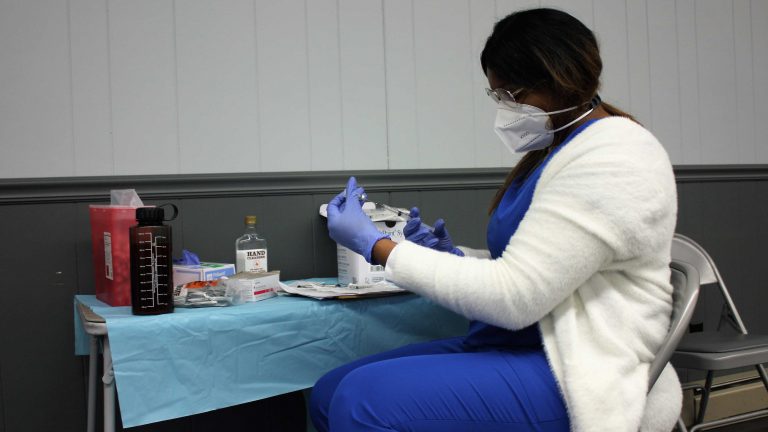Some states are saying they won’t use Johnson & Johnson’s single-dose vaccine to immunize vulnerable, harder-to-reach populations, including agriculture workers, over concerns about equity and perceptions of how well it protects against COVID-19.
Listen here
The recently-authorized vaccine proved safe and effective in its clinical trial and was 100% effective in preventing hospitalization and death from COVID-19. It’s a welcome third option that provides a way around logistical hurdles presented by the Pfizer and Moderna vaccines, including ultra-cold storage and the requirement for two doses spaced weeks apart.
Johnson & Johnson’s vaccine did, however, report a slightly lower efficacy than the other two FDA-authorized vaccines.
Both the Pfizer and Moderna vaccines reported efficacies close to 95%. Overall, Johnson & Johnson’s vaccine proved to be 66% effective at preventing moderate to severe disease. That number differs by location, though, and is closer to 72% in the United States. It’s also important to note that Johnson & Johnson’s clinical trial occurred later, when more coronavirus variants were running rampant, so these are not head-to-head comparisons.
Still, the Illinois Department of Health (IDPH) won’t be using their Johnson & Johnson doses to vaccinate farmworkers.
“I need to stick with Pfizer and Moderna,” says Omayra Giachello, regional health officer with IDPH.
Giachello has been working under the state health department’s Office of Minority Health to host pop-up vaccine clinics targeting essential workers, including agricultural workers.
“We wanted to make sure we reach underserved communities, people that are migrants… factory workers, essential workers,” she says. “We wanted to make sure there’s equality with vaccinations.”
Giachello says she was initially excited when the Johnson & Johnson vaccine was authorized because it would’ve made her job a lot easier. Instead of planning two clinics for each community and securing enough doses for each, she would only need to plan for one. More workers would be vaccinated in the process, too, and potentially wouldn’t have to miss two days of work to do so.
However, the Illinois state health department decided against using the single-dose vaccine for these clinics for fear of public backlash.
“It might be, ‘Oh really, you’re going to give them that because they’re African American [or] because they’re migrants?’” Giachello says. “‘They should be given the same rights as someone that’s Anglo Saxon, get that Moderna, the Pfizer, that’s being offered.’”
Health experts have been vocal about the fact that all three vaccines protect against hospitalization and death due to COVID-19 and that the best vaccine is the one that becomes available to you first.
However, Illinois state health officials fear that public perception of the differing efficacy numbers might lead vulnerable populations to believe that they’re receiving the lesser vaccine.
“‘Hey, it’s 96% here and 96 for that… and then you’re going to give me something that’s 72 or maybe even up a little bit in the 80s… why am I gonna get [that one]?’” she says. “They might think it’s not effective.”
Other states, though, are welcoming the Johnson & Johnson vaccine as a way around the two-dose logistical hurdles. North Carolina’s health department is working with meatpacking companies, including Tyson Foods and Smithfield, to secure doses for their workers.
Iowa recently announced that they are directing their Johnson & Johnson vaccines to counties that are home to large populations of essential workers, including meatpacking plant workers. A press release states that these workers “have been disproportionately affected by the virus” and that the one-and-done vaccine will make “it less logistically complex to handle and administer.” Thousands of Iowa meatpacking plant workers have already been vaccinated.
Iowa Gov. Kim Reynolds opted to receive the Johnson & Johnson vaccine on live television to demonstrate her faith in the vaccine.
“I wanted to [assure] Iowans that I believe it is a safe vaccine and not to be afraid to take it,” Reynolds said.
At a recent White House press briefing, federal health officials said they think distribution of the three different vaccines should be equitable across communities.
“We will be tracking biometrics, such as ZIP code and social vulnerability, to see where vaccines are going,” said Dr. Marcella Nunez-Smith, chairwoman of the Biden administration’s new health equity task force. “Should certain vaccines go consistently to certain communities, we will be able to intervene.”
Intervening would mean communicating with and providing technical assistance to states or other providers who aren’t adhering to guidance, health officials said. Non-compliance would not result in a loss of doses.
However, Nunez-Smith emphasized that although not all vaccines are created equal, they can all save your life.
“As a physician, I strongly urge everyone in America to get the first vaccine that is available to you when it is your turn,” she said. “If people want to opt for one vaccine over another, you know, they may have to wait. Time is of the essence; getting vaccinated saves lives.”
Follow Dana on Twitter: @DanaHCronin
9(MDM5MjE5NTg1MDE1Mjk1MTM5NjlkMzI1ZQ000))

